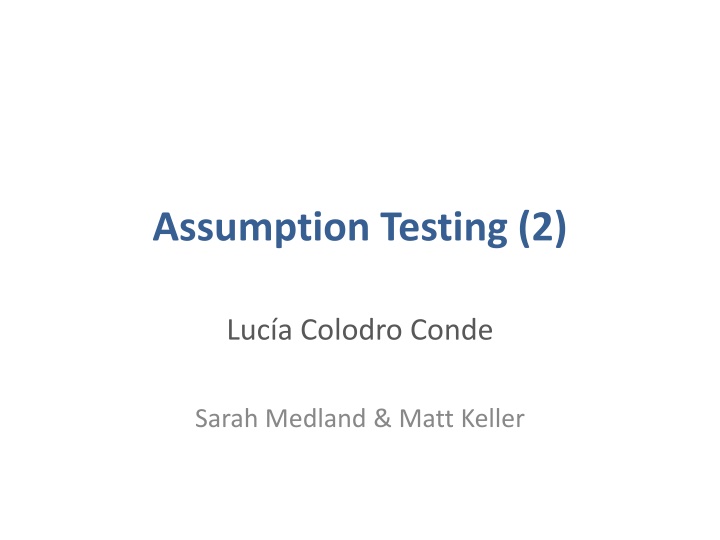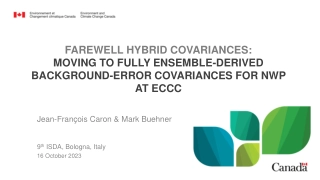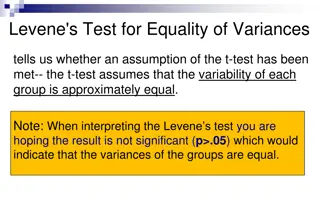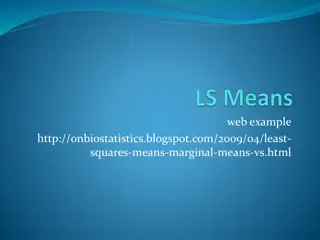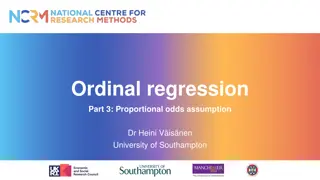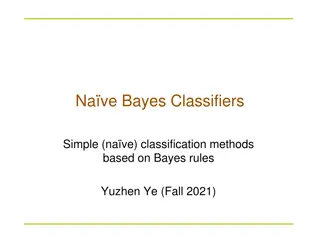Assumption Testing for Homogeneity of Means, Variances, and Covariances
In the context of twin studies, examining data for homogeneity of means, variances, and covariances is crucial. This involves testing hypotheses related to differences across twin pairs based on zygosity, sex, and other factors. Various statistical models are utilized to assess the presence of genetic and environmental influences on traits. The comparison of saturated and constrained models helps determine the significance of covariates in shaping trait outcomes. Additionally, hypotheses concerning means, variances, and covariances provide insights into genetic effects and familial aggregation. Reading materials by Evans, Frazer, and Martin offer valuable insights into genetic and environmental causes of trait variation.
Download Presentation

Please find below an Image/Link to download the presentation.
The content on the website is provided AS IS for your information and personal use only. It may not be sold, licensed, or shared on other websites without obtaining consent from the author.If you encounter any issues during the download, it is possible that the publisher has removed the file from their server.
You are allowed to download the files provided on this website for personal or commercial use, subject to the condition that they are used lawfully. All files are the property of their respective owners.
The content on the website is provided AS IS for your information and personal use only. It may not be sold, licensed, or shared on other websites without obtaining consent from the author.
E N D
Presentation Transcript
Assumption Testing (2) Luc a Colodro Conde Sarah Medland & Matt Keller
Assumption testing What? Need to examine the data to check for: 1. homogeneity of means 2. homogeneity of variance / standard deviation 3. homogeneity of covariance / correlation between co twins, across zygosity groups 4. What covariates should be applied The goodness-of-fit statistic of this saturated model is later compared to that of the more reduced (constrained) models in which certain parameters are: - equated, to test for homogeneity of these parameters, or - dropped (i.e., fixed to equal zero), to test whether covariates significantly influence the trait.
Hypotheses concerning means H0m:Fully saturated model. H1m: presence of birth order effects equate means for twin 1 and twin 2 within same sex pairs. H2m: homogeneity of means between MZ and DZ twins within like-sex twin pairs equate means across same sex MZ twins and equate means across same sex DZ twins. H3m: homogeneity of means between MZ and DZ twins within all female twins and within all male twins equate means across all female twins and equate means across all male twins. H4m: homogeneity of means between male and female twins equate all means . We retain differences in means in males and females if needed
Hypotheses concerning variances H0v:Fully saturated model. H1v: presence of birth order effects equate variances for twin 1 and twin 2 within same sex pairs. H2v: homogeneity of variancesbetween MZ and DZ twins within like-sex twin pairs equate variances across same sex MZ twins and equate means across same sex DZ twins. H3v: homogeneity of variancesbetween MZ and DZ twins within all female twins and within all male twins equate variances across all female twins and equate means across all male twins. H4v: homogeneity of variancesbetween male and female twins equate all variances .
Hypotheses concerning covariances H0c: saturated full model. H1c: presence of scalar sex limitation equate the covariances of MZ twins, and equate the covariances of same-sex DZ twins. H2c: presence of non scalar sex limitation equated the covariances of MZ twins and the covariances of all DZ twins. H3c: variance on a trait is influenced by genetic factors equate all covariances. H4c: presence of familial aggregation set all covariances to zero. This is a preliminary test for genetic effects. Shall we model: ACE vs ADE? Sex limitation?
Useful reading Evans, D., Frazer, I.H., Martin, N.G. (1999). Genetic and Environmental Causes of Variation in Basal Levels of Blood Cells. Twin Research2 (4), 12, 250-257. Rijsdijk, F. V., Sham, P. C. (2002). Analytic approaches to twin data using structural equation models. Briefings in Bioinformatics, 3, 119-133. Verweij, K.J.H., Mosing, M.A., Zietsch, B.P., & Medland, S.E. (2012). Estimating heritability from twin studies. Methods in Molecular Biology, 850, 151-170.
It is the pattern of covariance across different zygosity groups that is the focus of twin studies Twin correlations ~ sources of variance
Sex differences in genetic variation The size and aetiology of genetic variation between males and females are not necessarily the same. This is known as sex limitation. Scalar sex limitation occurs when the same set of genes operates in males and females, but the magnitude of the genetic effect differs between the sexes. rMZF rMZM & rDZF rDZM Non-scalar sex limitation occurs when different genes in males and females affect expression of the phenotype. rDZM rDOS * We need data for male and female MZ twin pairs, and male, female, and opposite-sex DZ twin pairs
